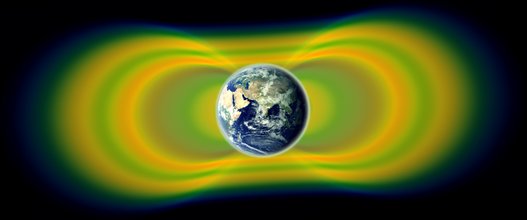Van Allen belts
Bron: Wikipedia
Van Allen belts, also called radiation belts or particle belts, are two belts of charged particles around the earth. The lowest-lying belt, at a distance of 2000-5000 km, consists mainly of protons. This was discovered in 1958 by the satellite Explorer 1. The belt is named after its discoverer James Van Allen, who insisted that the satellite would take a geiger counter on board.
The second belt is at a height between 13000 and 19000 km and is about 6000 km thick. This belt consists mainly of electrons and was discovered and mapped by Pioneer 1, 2 and 3 (also in 1958).
The particles in the outer Van Allen belt originate from the solar wind, the particles in the inner belt(s) come from cosmic radiation.

Foto: NASA
Physical background
Van Allen belts consist of charged particles that arrive at the earth at high speed. Around the earth these particles meet the magnetic field of the earth (the magnetosphere). There is actually the same effect as in a dynamo or an eddy current brake.
Because of the shape of the magnetic field, concentrated around the poles, the particles are held in the magnetic field. The charged particles move along magnetic field lines from the north pole to the south pole and back.
Height
The Van Allen belts are for the most part at a considerable height above the earth's surface, but that is not everywhere the case. Around the poles, the magnetic field lines approach the earth's surface. A large proportion of the charged particles are returned to the other pool, a small number of which can reach a height of 40 to 50 km. At that height are not many air molecules, but enough to cause the northern and southern light to arise in the collision between fast charged particles and air molecules.
The earthly magnetic field
Bron: Stefan Deiters - Astronomy
Like other planets, the earth has a magnetic field. Magnetic fields are created by the flow of electrically conductive materials, for example from liquid metals (iron, nickel), deep below the surface of the celestial body. The correct mechanism is not yet known.
On earth, the magnetic field has become increasingly subdued over the past 2,000 years and it will disappear completely in the future for a short time. It has been determined that the polarity of the earth's magnetic field reverses with some regularity. According to geological surveys that happens about every 250,000 years. A correct explanation for this phenomenon is not yet available.
The magnetic field of the earth extends far into the universe as a magnetosphere, where it is deformed by the solar wind. The actually spherical shape is compressed on the side of the sun and extended on the other side. The magnetic field protects against the solar wind and is indispensable for the preservation of life.
The shape of the terrestrial magnetic field can be compared to the field of a rod magnet that is located near the center of the earth. The field makes an angle of about 11 degrees with the axis of rotation of the earth. Because of the opposite poles it is also called 'dipoIe field'. The magnetic north and south poles do not coincide with the geographical poles. A compass needle therefore only indicates approximately the north-south direction.
Translation by Google Translate
back to the symbol 'universal spirit spark'
^